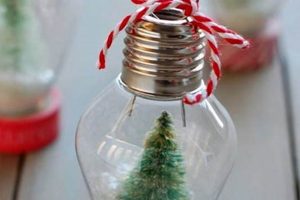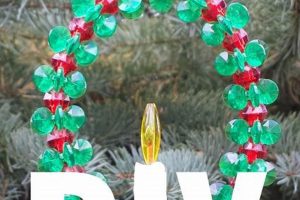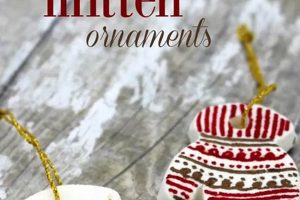Creating decorative items using felt fabric and individual craftsmanship allows for personalized embellishments, particularly suitable for seasonal adornments. A typical instance involves cutting shapes from felt, stitching them together, and adding details such as embroidery or beads to form a Christmas tree decoration. This approach offers a customizable and hands-on method for producing unique holiday accents.
The practice of crafting with felt provides numerous advantages, including accessibility, affordability, and ease of use. Historically, felt has been employed in various handicraft traditions. Its versatility allows for intricate designs and offers a tactile and visually appealing result. These handcrafted creations can serve as cherished keepsakes, reflect personal styles, and promote environmentally conscious practices by utilizing repurposed materials.
Subsequent sections will delve into specific techniques for achieving professional-looking results. A focused examination of essential tools and materials, followed by a series of step-by-step instructions for various project types, will be presented. Additionally, strategies for incorporating diverse design elements and exploring advanced embellishment methods will be discussed.
Crafting Refined Felt Adornments
The following recommendations are designed to elevate the quality and aesthetic appeal of handmade decorations. Diligent application of these principles will contribute to the creation of polished and enduring pieces.
Tip 1: Selection of Superior Materials. Opt for wool felt or wool-blend felt over acrylic alternatives. Wool varieties exhibit increased durability, a richer texture, and superior colorfastness, contributing to a lasting and visually appealing final product.
Tip 2: Precise Pattern Transfer. Ensure accurate transfer of design templates onto felt. Employ fine-tipped marking implements, such as felt-tip pens specifically designed for fabric, and exercise care to avoid distortion or smudging.
Tip 3: Emphasize Exact Cutting Techniques. Sharp, dedicated fabric scissors are paramount for achieving clean, precise edges. Maintain a consistent cutting angle to minimize fraying and ensure a professional finish.
Tip 4: Implement Calculated Stitching Methods. Employ appropriate stitch types, such as the blanket stitch or whip stitch, to secure felt layers. Maintain uniform stitch length and tension to create a visually consistent and structurally sound seam.
Tip 5: Incorporate Thoughtful Embellishments. Augment simple designs with strategically placed beads, sequins, or embroidery. Consider color palettes and material weights to achieve harmonious integration and avoid overwhelming the core design.
Tip 6: Employ Proper Stuffing Techniques. When creating three-dimensional forms, use polyester fiberfill sparingly and evenly. Overstuffing can distort the shape, while insufficient stuffing will result in a limp appearance. Employ small tools to distribute the filling into tight corners.
Tip 7: Secure all attachments. Verify that all glued or sewn attachments are completely secure and can withstand normal handling. Use appropriate adhesives formulated for fabric and reinforce stitching where possible.
Adhering to these guidelines promotes craftsmanship and leads to elevated aesthetic results. The resultant decorative elements will exemplify the dedication and precision invested in their creation.
The subsequent section will explore advanced construction and design methodologies to further refine the creation process.
1. Material Selection
The selection of appropriate materials is paramount in the successful creation of durable and aesthetically pleasing decorations. The inherent qualities of the chosen felt directly influence the final product’s texture, color vibrancy, and longevity, thus impacting the overall quality of handcrafted embellishments.
- Felt Fiber Composition
The fiber composition of the felt dictates its performance characteristics. Wool felt, known for its durability, rich texture, and resistance to pilling, stands in contrast to synthetic alternatives like acrylic felt. Acrylic felt, while more economical, often exhibits a less refined texture, diminished colorfastness, and increased susceptibility to wear. The choice between natural and synthetic fibers thus represents a trade-off between cost and quality.
- Felt Weight and Thickness
The weight and thickness of the felt influence its structural properties and suitability for specific design elements. Thicker felt provides greater stability for three-dimensional forms and intricate details, while thinner felt is better suited for delicate appliqus and layering techniques. Selecting the appropriate weight ensures the finished piece retains its intended shape and withstands handling.
- Colorfastness and Dye Quality
The colorfastness of the chosen felt is critical in maintaining the ornament’s aesthetic appeal over time. Substandard dyes can fade or bleed upon exposure to light or moisture, compromising the visual integrity of the design. Opting for high-quality, colorfast materials ensures the decorations retain their vibrancy and resist discoloration, even after prolonged use or storage.
- Texture and Surface Finish
The texture and surface finish of the felt contribute significantly to the ornament’s tactile and visual appeal. A smooth, even surface facilitates clean cutting and precise stitching, while a subtly textured surface adds visual interest and depth. The chosen texture should complement the overall design aesthetic and enhance the sensory experience of the finished piece.
In conclusion, a judicious approach to material selection is indispensable in ensuring the creation of aesthetically pleasing and enduring decorations. The careful consideration of fiber composition, weight, colorfastness, and texture directly impacts the final product’s quality and long-term appeal, transforming a simple craft project into a cherished heirloom.
2. Template Precision
Template precision constitutes a foundational element within the realm of felt-based decorative creation. In the context of creating adornments, the accuracy of the template directly influences the final form and proportions of the item. Deviation from the intended design, caused by inaccuracies in the template, can result in distorted shapes, misaligned components, and an overall reduction in the aesthetic quality of the ornament. For instance, a poorly drafted heart template will inevitably yield a heart-shaped ornament lacking symmetry and visual appeal. The correlation between template fidelity and the resulting product is thus one of direct cause and effect; a precise template invariably leads to a more refined and aesthetically pleasing outcome.
The practical significance of precise templates extends beyond mere aesthetics. Accurate templates ensure consistency in the production of multiple ornaments, a crucial factor when crafting matching sets or producing items for sale. Furthermore, precise templates minimize material waste by allowing for efficient cutting and reducing the likelihood of errors that necessitate recutting. Consider the creation of multiple star ornaments for a holiday tree; a precise star template ensures that each star is uniform in size and shape, creating a cohesive and professional presentation. This level of consistency is unattainable without meticulously crafted templates.
In summary, the importance of template precision in felt-based ornament creation cannot be overstated. It directly affects the visual appeal, structural integrity, and overall consistency of the final product. While challenges may arise in creating and maintaining accurate templates, the benefits of precision in terms of aesthetic outcome and material efficiency far outweigh the initial investment of time and effort. The adherence to template precision is not merely a matter of technique; it is a fundamental principle that underpins successful execution and elevates the quality of handcrafted decorative items.
3. Cutting Accuracy
In the creation of felt embellishments, cutting accuracy directly influences the final aesthetic and structural integrity. Irregular cuts introduce asymmetry and compromise the intended design. Sharp scissors are crucial for precise edges, eliminating frayed ends. Consider a felt reindeer ornament: accurate cuts define the antlers, legs, and facial features. Inaccurate cuts blur these details, diminishing the reindeer’s recognizability and visual appeal. This direct cause-and-effect relationship underscores the importance of meticulous cutting techniques.
Cutting accuracy has practical implications beyond aesthetics. Precise cuts facilitate seamless stitching and joining of felt pieces. Mismatched edges increase the difficulty of sewing and result in visible imperfections. In the construction of a layered felt flower ornament, accurately cut petals align perfectly, creating a smooth, professional finish. Conversely, uneven petals disrupt the flower’s form and require significant adjustments, wasting time and materials. Therefore, the ability to cut precisely is a prerequisite for efficient and high-quality ornament creation.
Achieving cutting accuracy requires patience and appropriate tools. Investing in sharp fabric scissors and employing techniques like tracing templates with precision are essential. Challenges may arise from complex shapes or intricate designs. However, mastering cutting accuracy elevates the overall quality of handmade felt ornaments. This skill contributes significantly to the creation of visually appealing and durable pieces. By focusing on accurate cutting, individuals enhance the craftsmanship and lasting value of their decorative felt creations.
4. Stitching Technique
Stitching technique forms an integral component in the creation of handcrafted felt decorations. The chosen method of stitching directly impacts the structural integrity, aesthetic presentation, and overall durability of the completed ornament. Proper execution ensures secure seams, refined edges, and the effective integration of various design elements.
- Blanket Stitch Application
The blanket stitch serves as a common edging technique, creating a decorative border while simultaneously securing the felt layers. Applied around the perimeter of a felt star, the blanket stitch prevents fraying and adds a visual element. Irregular spacing or tension in the blanket stitch can detract from the ornament’s aesthetic appeal and compromise the seam’s strength.
- Whip Stitch Implementation
The whip stitch offers a simpler alternative for joining felt pieces. This stitch involves wrapping the thread over the edges of two felt layers. While faster than the blanket stitch, the whip stitch may not provide the same level of decorative detail or edge security. Improperly executed whip stitches can result in uneven seams and potential separation of the felt layers over time.
- Back Stitch Detailing
The back stitch is utilized for adding fine details and embellishments. It is particularly suitable for creating embroidered accents or outlining specific features on the ornament. For example, a back stitch can be employed to depict the veins on a felt leaf or to define the eyes of a felt animal. Inconsistent stitch length or incorrect placement can disrupt the intended design.
- Invisible Stitch Methods
Invisible stitching techniques, such as the slip stitch, are employed to conceal seams and create a seamless appearance. This is often used when attaching appliqus or joining complex shapes. When attaching a felt heart to a larger felt square, a slip stitch hides the seam, creating a clean and professional look. A poorly executed invisible stitch can result in visible thread and a less polished finish.
In summary, the deliberate selection and skillful execution of stitching techniques are crucial factors in producing well-crafted felt decorations. The interplay between stitch type, thread tension, and stitch placement determines the ornament’s structural soundness and visual appeal. Mastery of these techniques ensures that handmade felt decorations exhibit both durability and aesthetic quality.
5. Embellishment Integration
Embellishment integration constitutes a critical phase in the creation of felt decorations, directly influencing the aesthetic quality and perceived value of the final product. The addition of supplementary details, such as beads, sequins, embroidery, or other decorative elements, serves to elevate the visual complexity and artistic merit of otherwise simple felt forms. In effect, the thoughtful incorporation of embellishments transforms a basic felt shape into a more engaging and visually compelling ornament. For example, the addition of seed beads along the edges of a felt snowflake ornament not only enhances its visual appeal but also provides a textural contrast that draws attention to the snowflake’s intricate design. Conversely, a poorly executed embellishment scheme can detract from the ornament’s overall aesthetic, rendering it appear cluttered or unbalanced. The causal relationship between embellishment integration and the final product’s quality is thus apparent.
The practical significance of understanding embellishment integration extends to considerations of cost-effectiveness and design versatility. Strategic placement of relatively inexpensive embellishments can significantly increase the perceived value of a handmade ornament, allowing for the creation of visually striking pieces without incurring substantial material costs. Furthermore, the flexibility afforded by various embellishment techniques allows for adaptation to different design styles and aesthetic preferences. For instance, a simple felt bird ornament can be rendered in a rustic style through the addition of wooden beads and twine, or transformed into a more elegant piece through the incorporation of iridescent sequins and silk ribbon. The ability to effectively integrate embellishments thus empowers crafters to create a diverse range of felt ornaments tailored to specific market segments or personal tastes. A felt christmas tree with star beads can be sold at a higher price due to its design.
In summary, effective embellishment integration represents a key determinant of success in creating felt decorations. The careful selection and skillful application of supplementary design elements can significantly enhance the aesthetic appeal, perceived value, and design versatility of handmade ornaments. While challenges may arise in achieving a harmonious balance between the base felt form and the added embellishments, the benefits of thoughtful integration in terms of visual impact and market appeal are undeniable. Mastering embellishment integration is crucial for crafting felt ornaments that resonate with consumers and stand apart from mass-produced alternatives.
Frequently Asked Questions
This section addresses common inquiries regarding the creation of handmade decorations, providing clarity on essential techniques and materials.
Question 1: What type of felt is most suitable for durable and aesthetically pleasing ornaments?
Wool felt or wool-blend felt is generally recommended. These materials offer superior durability, a richer texture, and improved colorfastness compared to synthetic alternatives like acrylic felt.
Question 2: How can precise pattern transfer onto felt be achieved?
Utilizing fine-tipped marking implements, such as fabric-specific felt-tip pens, is advisable. Exercise caution to avoid distortion or smudging during the tracing process.
Question 3: What constitutes the best practice for cutting felt to ensure clean edges?
Sharp, dedicated fabric scissors are essential. Maintain a consistent cutting angle to minimize fraying and achieve a professional finish.
Question 4: Which stitching method is most effective for securing felt layers and creating a decorative border?
The blanket stitch is commonly employed for both purposes. This stitch provides a secure seam and enhances the visual appeal of the ornament’s edges.
Question 5: How should embellishments, such as beads or sequins, be incorporated to complement the overall design?
Strategically place embellishments to enhance visual interest without overwhelming the base felt form. Consider color palettes and material weights for harmonious integration.
Question 6: What is the proper technique for stuffing three-dimensional felt ornaments?
Use polyester fiberfill sparingly and evenly. Overstuffing can distort the shape, while insufficient stuffing results in a limp appearance. Employ small tools to distribute the filling into tight corners.
These answers provide foundational guidance for individuals seeking to create high-quality felt decorations. Adherence to these principles contributes to the production of visually appealing and enduring pieces.
The subsequent section will explore advanced construction and design methodologies to further refine the creation process.
Conclusion
The preceding exploration of “diy ornaments felt” has elucidated critical factors impacting the final product’s quality, durability, and aesthetic value. From material selection and template precision to cutting accuracy, stitching technique, and embellishment integration, each element demands careful consideration. Mastery of these aspects elevates the craftsmanship and contributes to the creation of visually appealing and enduring handmade decorative items.
Continued refinement of these skills, coupled with ongoing exploration of innovative design approaches, will further enhance the potential for personalized expression and creative fulfillment within the realm of handcrafted embellishments. The enduring appeal of such creations lies in their capacity to reflect individual artistry and provide a tangible connection to cherished traditions. Further dedication will elevate this craft even higher.







